

Radio art of Tetsuo Kogawa. Coppice ‘Vinculum (Coincidence): Indexed Conjectures Of Coincidence Imprints Once Happened’ (13) Vinculum (Coincidence) is the latest installment from Coppice’s archive of sonic artifacts.
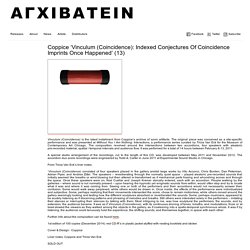
The original piece was conceived as a site-specific performance and was presented at Without You I Am Nothing: Interactions, a performance series curated by Tricia Van Eck for the Museum of Contemporary Art Chicago. The composition revolved around the intersections between two accordions, four speakers with aleatoric pre-recorded material, spatial / temporal intervals and audience flow. It was performed for a total of 14 hours between February 8-13, 2011. A special studio arrangement of the recordings, cut to the length of this CD, was developed between May 2011 and November 2012.
The accordion duo score recordings were engineered by Todd A. Five Days at the BBC Radiophonic Workshop Part 1. Sonic boom : selected works. SONIC BOOM - view lower galleries plans An exhibition of sound art curated by David Toop and presenting the works of twenty six artists.
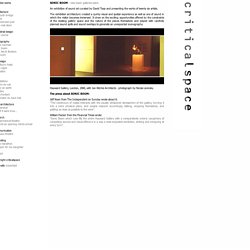
The exhibition architecture created a quirky visual and spatial experience as well as one of sound in which the visitor becomes immersed. It drew on the exciting opportunities offered by the constraints of the existing gallery space and the nature of the pieces themselves and played with carefully planned sound spills and sound overlaps to generate an unexpected scenography. Hayward Gallery, London, 2000, with Ian Ritchie Architects - photograph by Nicola Levinsky. The press about SONIC BOOM: Jeff Noon from The Independent on Sunday wrote about it:“The continuum of noises interacts with the usually whispered atmosphere of the gallery, turning it into a more physical place, and people respond accordingly, talking, enjoying themselves, and getting as close as possible to the work”.
Experimental music & sound art archive. Audio Chaos - Generate Soundscapes. Morezane. Dwau I : Dwau Marcel Munoz Manuel Orellana 2013. <div style="padding:5px; font-size:80%; width:300px; background-color:white; margin-left:auto; margin-right:auto; border:1px dashed gray;"> Internet Archive's<!

--'--> in-browser audio player requires JavaScript to be enabled. It appears your browser does not have it turned on. Please see your browser settings for this feature. Meditación 66 : Manuel Orellana Sandoval. <div style="padding:5px; font-size:80%; width:300px; background-color:white; margin-left:auto; margin-right:auto; border:1px dashed gray;"> Internet Archive's<!

--'--> in-browser audio player requires JavaScript to be enabled. It appears your browser does not have it turned on. Please see your browser settings for this feature. </div> Más que el ruido Improvisación con Mari Kimura. History of Phonograph Record Technology- "Electrically" Recorded Discs. Technical change was afoot.
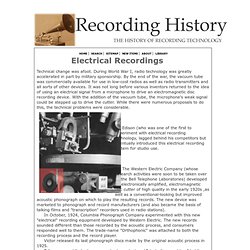
During World War I, radio technology was greatly accelerated in part by military sponsorship. Talking Motion Pictures. Talking Motion Pictures "The advent of American talking movies is beyond comparison the fastest and most amazing revolution the whole history of industrial revolutions.
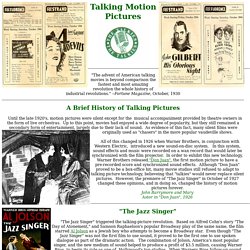
" --Fortune Magazine, October, 1930 A Brief History of Talking Pictures Until the late 1920's, motion pictures were silent except for the musical accompaniment provided by theatre owners in the form of live orchestras. KDKA, First Commercial Radio Station. A Science Odyssey: People and Discoveries: KDKA begins to broadcast. KDKA begins to broadcast1920 Photo: Beginnings of KDKA, with entire staff of four On Christmas Eve, 1906, wireless operators on ships off the New England coast wondered if they'd had a religious experience.

Out of the midst of Morse code dots and dashes beeping through their headsets came the sound of a voice reading the Christmas story from the Gospel of Luke and a violin playing "Silent Night. " The voice wished them a merry Christmas, and then the dots and dashes started up again. Léon Theremin. Léon Theremin en 1924.
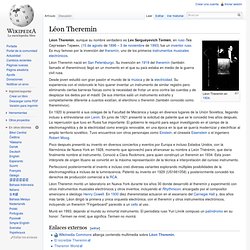
Léon Theremin, aunque su nombre verdadero es Lev Serguéyevich Termén, en ruso Лев Сергеевич Термен, (15 de agosto de 1896 – 3 de noviembre de 1993) fue un inventor ruso. Es muy famoso por la invención del theremín, uno de los primeros instrumentos musicales electrónicos. Léon Theremin nació en San Petersburgo. Theremin Virtuoso Pamelia Kurstin and Pianist Pete Drungle Live in Studio 360. Leon Theremin playing his own instrument. The Futurist Intonarumori by Russolo - 2. Mike Patton plays the Intonarumori.
Russolo_noise. LUIGI RUSSOLO italian futurist "SERENATA" 1924 "The Art of Noise" 1913 [ITA-ENG] Russolo y la máquinas del ruido. Luigi Russolo. MultiPhone Phonograph. Flickr: Intercambio de fotos. 1939 AEG Magnetophon FT4 tape recorder playing Deutsches Tanz und Unterhaltungsorchester. 1900 Emperor Franz Joseph oldest magnetic recording on Poulsen Telegraphone. Valdemar Poulsen. Valdemar Poulsen (23 de noviembre de 1869 - 23 de julio de 1942) fue un inventor dinamarqués, más conocido por haber inventado el telegráfono, la primera máquina capaz de grabar sonido, de forma magnetica.
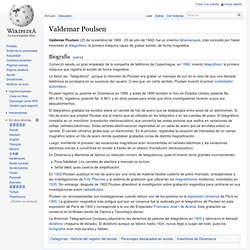
Guillermo Marconi. Berliner : El Gramófono. Emile Berliner. Emil Berliner (en inglés, su verdadero nombre en alemán era Emil Berliner) (20 de mayo de 1851 - 3 de agosto de 1929) fue un inventor alemán-estadounidense del transmisor telefónico, del gramófono, de los discos de vinilo y precursor del micrófono.
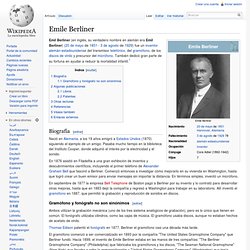
También dedicó gran parte de su fortuna en ayudar a reducir la mortalidad infantil.[1] Untitled. Graphophone. A Columbia 'Precision' Graphophone, a cylinder model sold in France, 1901. The Graphophone was the name and trademark of an improved version of the phonograph. It was invented at the Volta Laboratory established by Alexander Graham Bell in Washington, D.C., United States. Its trademark usage was acquired successively by the Volta Graphophone Company, then the American Graphophone Company, the North American Phonograph Company, and finally by the Columbia Phonograph Company (later to become Columbia Records), all of which either produced or sold Graphophones. Research and development[edit] Phonograph. Close up of the mechanism of an Edison Amberola, manufactured circa 1915 A late 20th-century gramophone turntable and record The phonograph, also called gramophone (from the Greek: γράμμα, gramma, "letter" and φωνή, phōnē, "voice") or record player, is a device introduced in 1877 for the recording and reproduction of sound recordings.
The recordings played on such a device consist of waveforms that are engraved onto a rotating cylinder or disc. As the cylinder or disc rotates, a stylus or needle traces the waveforms and vibrates to reproduce the recorded sound waves. Gramófono. Gramófono. Gramófono portátil. Prole.info. 07Epidaurus Theater07.jpg - Wikipedia, the free encyclopedia. The Mystery of Modern Acoustic in Ancient Greek Theatre Solved. The ancient Greeks were placing the last few stones on the magnificent theater at Epidaurus in the fourth century B.C. In the ancient Greece, it was one of the wonders of its time. Unwittingly, the ancient builders made a sophisticated acoustic filter that enabled audiences in the back row to hear music and voices with amazing clarity, thousands of years before modern acoustic could do this.
The ancient Greeks tried to replicate the Epidaurus' design, but without much success. New Atlantis. New Atlantis is a utopian novel by Sir Francis Bacon, published in Latin (as Nova Atlantis) in 1624 and in English in 1627. In this work, Bacon portrayed a vision of the future of human discovery and knowledge, expressing his aspirations and ideals for humankind. WORLD'S FIRST: Compact Disc Player made in 1982. Compact Disc. Standard CDs have a diameter of 120 millimetres (4.7 in) and can hold up to about 80 minutes of uncompressed audio or 700 MiB (actually about 703 MiB or 737 MB) of data. The Mini CD has various diameters ranging from 60 to 80 millimetres (2.4 to 3.1 in); they are sometimes used for CD singles, storing up to 24 minutes of audio or delivering device drivers. At the time of the technology's introduction it had much greater capacity than computer hard drives common at the time. The reverse is now true, with hard drives far exceeding the capacity of CDs.
In 2004, worldwide sales of CD audio, CD-ROM, and CD-R reached about 30 billion discs. IBM PC. El IBM Personal Computer (en español, computadora personal IBM u ordenador personal IBM), conocido comúnmente como IBM PC, es la versión original y el progenitor de la plataforma de hardware compatible IBM PC. Es el IBM modelo 5150, y fue introducido el 12 de agosto de 1981. Fue creado por un equipo de ingenieros y de diseñadores bajo la dirección de Don Estridge y William C. Lowe del IBM Entry Systems Division en Boca Raton, Florida. 2242120938_42c450b4fe.jpg (imagen JPEG, 500 × 346 píxeles) APK File Download Headquarters. Peter Gabriel and Fairlight CMI. Herbie Hancock jams with his Fairlight CMI. Fairlight CMI. Ambient.